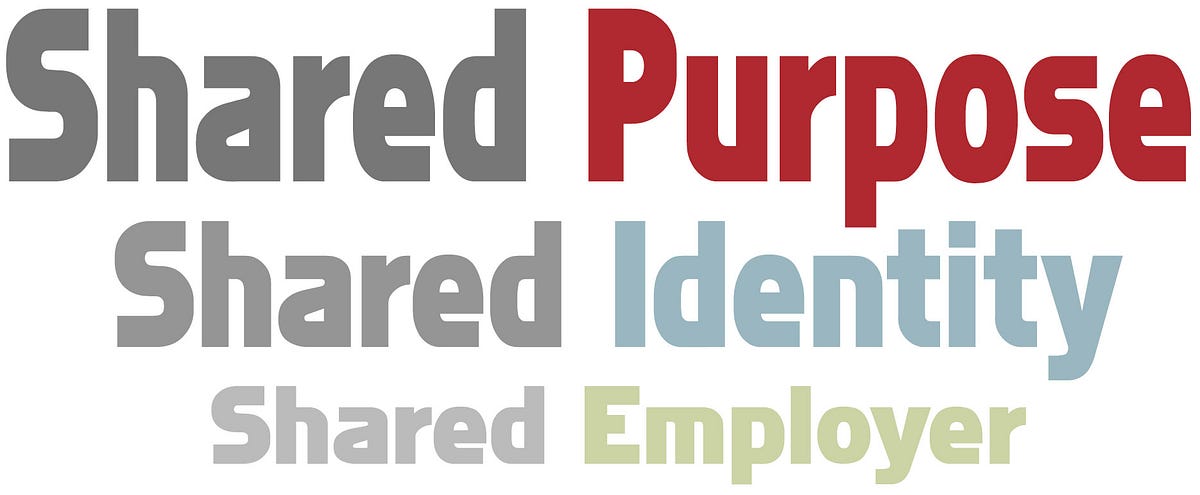Company Culture That Changes the World: Building a Shared Purpose Culture
By: Tim Cynova // Published: May 9, 2017
We hear a lot these days about the importance of having great organizational culture. “Culture eats strategy for breakfast” is the infamous Peter Drucker refrain. But what exactly do we mean by “great company culture,” let alone company culture that changes the world and enables people to leave their dent on the universe?
In the latest episode of How We Work:TV, we look at three types of organizational culture and how to start building the one that changes the world. The three include:

Shared Employer
In shared employer culture, we all just happen to work for that same organization. We don’t feel particularly connected to the company, our coworkers, or what we do. We’re essentially playing on a golf team — individually we play our game and then add up our separate scores at the end of the day to see how the team performed. Shared employer culture doesn’t change the world.
Shared Identity
The next level up is Shared Identity culture. For the most part in shared identity, we like where we work, the people we work with, and the work we do. We run 5Ks together, go out for drinks, and share common interests like the same books, hobbies, and the latest binge watching obsession.
Shared identity culture is an enviable thing, especially if you currently have a Shared Employer culture. People like each other, have a faster uptick as a team, and a shorthand because they have shared experiences and similar backgrounds. But shared identity only gets us so far. There’s another level up that becomes increasingly elusive to achieve the longer we stay at Shared Identity.
There’s also a significant danger with shared identity culture. That danger is that our sense of relatedness and connection to each other cannot only be damaging to our professional growth and personal well-being, but we become resistant to change because of the status quo’s powerful gravitational pull. We become resistant and less than welcoming to people and ideas that don’t quickly mesh with our experience and perspective.
Shared identity culture has another big trait that makes it difficult to change the world: it’s inward looking… us, we, me.
Research shows the more diverse teams and organizations are, the higher performing they can be. With shared identity we struggle to diversify our teams because of that inward focus. It changes our identify, and that leaves us struggling to level up. But for those who can confront this challenge, there’s something special waiting for you…
Shared purpose
Shared purpose culture is change-the-world level shit; for better or worse. In a shared purpose culture people are focused on, and aligned around, the organization’s vision. A vision that’s externally focused, outwardly directed, and therein lies the magic.
How do you build a shared purpose culture? First, figure out what your organization’s purpose is — your purpose, not your mission, they’re different. Your vision answers the question, “Why do you exist as a company,” Your mission answers the question, “What do we do?”
Once you figure out your purpose then run everything — activities, decisions, hiring — through that gauntlet. This takes intent until it becomes second nature.
What you’ll see in practice is not everyone aligns through shared purpose. Some people move no further than shared identity, and still a few others only see shared employer.
Our job as leaders is to manage an inverse pyramid. Get the most number of people in the shared purpose group, followed by fewer people in shared identity, and then fewer people still — hopefully as close to zero as possible — in the shared employer group. And over time, as your shared purpose culture becomes stronger and more ingrained, those in the other buckets start to opt out of your organization.
For more about how you can start creating a Shared Purpose culture, here’s a moving picture primer:
Thanks for watching!
Tim Cynova is a leader, HR consultant, and educator dedicated to co-creating anti-racist and anti-oppressive workplaces through using human-centered organizational design. He is a certified Senior Professional in HR, trained mediator, principal at Work. Shouldn’t. Suck., on faculty at New York’s The New School and Canada’s Banff Centre for Arts and Creativity, and for the past twelve years served as COO and then Co-CEO of the largest association of artists, creatives, and makers in the U.S.
